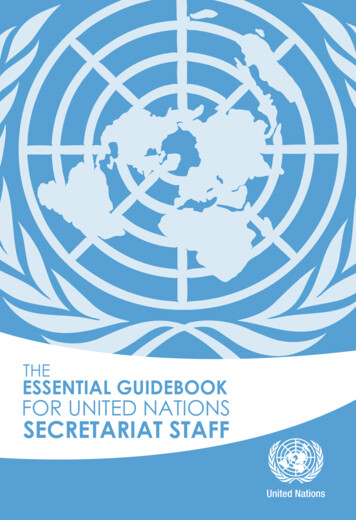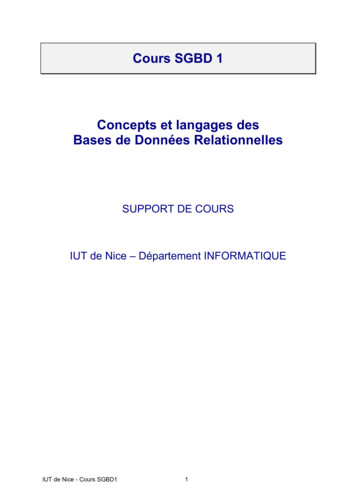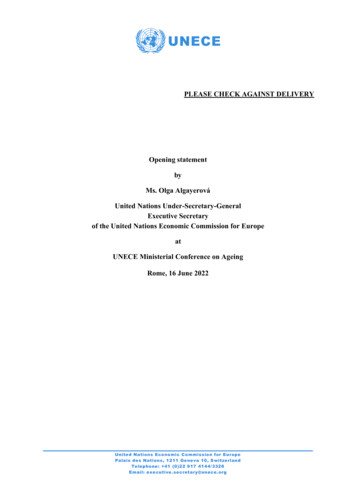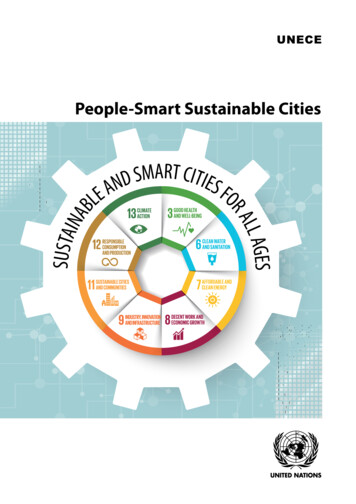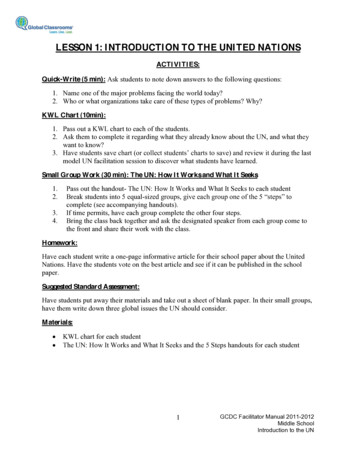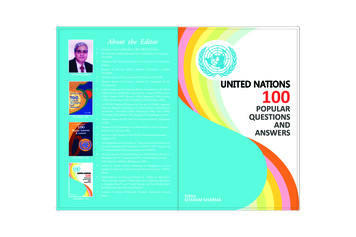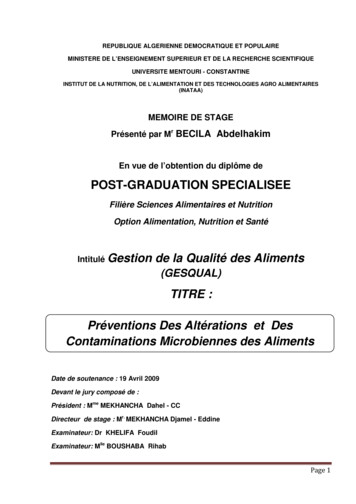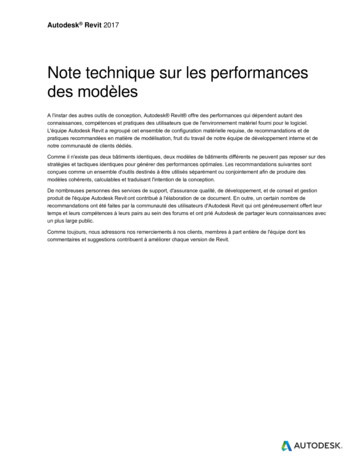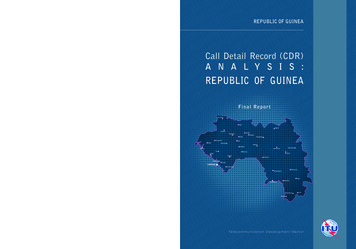
Transcription
REPUBLIC OF GUINEAInternational Telecommunication UnionTelecommunication Development BureauCall Detail Record (CDR)A N A L Y S I S :Place des NationsCH-1211 Geneva 20Switzerlandwww.itu.intREPUBLIC OF GUINEAFi n a l R e p o r tISBN-13: 978-92-61-22291-89 789261 222918Printed in SwitzerlandGeneva, 2017CALL D ETA IL RECORD ( CD R AN ALYSIS : REPU BL IC OF GU I N EAâTe l e c o m m u n i c a t i o n D e v e l o p m e n t S e c t o r
Call detail record (CDR)analysis: Republic of Guinea
This International Telecommunication Union (ITU) report was prepared by ITU expert ProfessorRyosuke Shibasaki of the Center for Spatial Information Science, University of Tokyo, under thesupervision of the Telecommunication Development Bureau (BDT) Least Developed Countries, SmallIsland Developing States and Emergency Telecommunications Division (LSE) in the Projects andKnowledge Management Department (PKM).The designations employed and presentation of material in this publication, including maps, do notimply the expression of any opinion whatsoever on the part of ITU concerning the legal status of anycountry, territory, city or area, or concerning the delimitations of its frontiers or boundaries.ISBN:978-92-61-22281-9 (Paper version)978-92-61-22291-8 (electronic version)978-92-61-22301-4 (EPUB version)978-92-61-22311-3 (MOBI version)Please consider the environment before printing this report. ITU 2017All rights reserved. No part of this publication may be reproduced, by any means whatsoever, without the priorwritten permission of ITU.
Table of Contents1Summary 12Background 13Mobile communications in Guinea 3.1 Mobile phone technology 3.2 Situation of mobile subscribers in Guinea 2234Call detail records (CDR) 4.1 Extracting human mobility and spatio-temporal distribution from CDR data 4.2 Public and private sector impact 4455CDR data sets and basic statistics 66CDR data: Limitations and difficulties 87Methodology 7.1 Overview of CDR data analysis (including stakeholders) 7.2 Overview of CDR data analysis work flow 7.3 CDR data specification 7.4 CDR processing procedure 7.5 Interpolation format specification 7.6 Hadoop system for data processing 7.7 Dynamic population estimation 7.8 Mobile phone and SIM card cloning 99101011141718208Analysis results 8.1 Mobile phone user population by Prefecture 8.2 People flow visualization using interpolation result 8.3 Movement of people from one town (over 48 hours) 8.4 Tracing people who passed through a hazard area 8.5 Attempt to detect cloning phones and SIM cards 8.6 Transboundary analysis 8.6.1 CDR data set with transboundary IMEI 8.6.2 Daily activity statistics 8.6.3 Inbound transboundary population movement 8.6.4 Outbound transboundary population movement 21212224272830313133349Discussions 36Appendix 1: Overall concept of automated CDR data analysis 38Appendix 2: Building points of interest (POIs) and road networks 39iii
List of Tables, Figures and BoxesivTablesTable 1: Sample CSV file data 16FiguresFigure 3.1: Commutation basis of GSM system Figure 3.2: Administrative map of Guinea Figure 5.1: Cell tower location at Guinea Figure 5.2: CDR data set Figure 5.3: Daily call activity Figure 5.4: Daily unique user Figure 5.5: Average total unique location (daily) Figure 7.1: Overall concept of CDR data analysis Figure 7.2: Overview of CDR analysis work flow Figure 7.3: CDR processing procedure Figure 7.4: CDR process of stay point extraction Figure 7.5: Distribution of POIs and process of stay point reallocation Figure 7.6: An example of a shortest path search result Figure 7.7: Conceptual framework of the process of shortest path search Figure 7.8: Distribution of POIs and process of stay point reallocation Figure 7.9: Trajectory data and stay point Figure 7.10: Time sequential trip points Figure 7.11: Trajectory check (internal use) Figure 7.12: Sample Hadoop Cluster Figure 7.13: Home location identification with population magnification Figure 7.14: On a daily based data aggregation for dynamic population estimation Figure 8.1: Mobile phone user population by Prefecture Figure 8.2: Most visited locations by the people living in Conakry Figure 8.3: Second most visited locations by the people living in Conakry Figure 8.4a: People flow at 6 a.m. and 9 a.m. Figure 8.4b: People flow at 12 p.m. and 3 p.m. Figure 8.5: Flow from a specific town (over 48 hours) Figure 8.6a: Distribution of people who are/are not in a hazard area Figure 8.6b: Trace people who passed through a hazard area (after 10 hours) Figure 8.7a: Where did they go in next 48 hours? (After 12 hours) Figure 8.7b: Where did they go in next 48 hours? (After 47.5 hours) Figure 8.8: Cloning detection (cloning IMEI) Figure 8.9: Cloning detection (cloning IMSI) Figure 8.10: CDR data set with transboundary IMEI of Guinea Figure 8.11: Daily call activity of Guinea based mobile users visiting Sierra Leone Figure 8.12: Daily call activity of Guinea mobile users visiting Liberia Figure 8.13: Daily unique users of Guinea mobile users visiting Sierra Leone Figure 8.14: Daily unique users of Guinea mobile users visiting Liberia Figure 8.15: Footprint of inbound mobile users to Guinea Figure 8.16: Number of mobile users moving into Guinea Figure 8.17: Footprint of visitors to Sierra Leone Figure 8.18: Footprint of visitors to Liberia Figure 8.19: Origin and destination of transboundary population to Sierra Leone Figure 8.20: Origin and destination of transboundary population to Liberia Figure A.1.1: Overall concept of CDR data analysis Figure A.2.1: Building POI in West Africa 2828293031313232333334343535363839
Figure A.2.2: Road network data in West Africa Figure A.2.3: Assessment of road network in West Africa Figure A.2.4: Extracting road network in West Africa 394040v
Call detail record (CDR) analysis: Republic of Guinea1SummaryThe mobile phone is one of the most ubiquitous technologies of the modern era, being used as atool not only for communication but also for information provision in sectors such as government,finance, education, agriculture, and health. It is especially important in the field of disaster andemergency management, providing crucial estimates of the number and movement of people priorto or during such events.The situation in the Republic of Guinea is a prime example, being heavily impacted by the Ebolaoutbreak, along with neighbouring countries, Liberia and Sierra Leone, where an understandingof human mobility was critical to an effective intervention policy to tackle the disease. BecauseEbola is an epidemic disease, by understanding human mobility, authorities can build models thatare essential when making decisions, efficient policies, and interventions to contain and tackle thedisease effectively.Call detail record (CDR) data provides information about activities on a mobile communicationnetwork and aggregated human mobility that can enable swift action against the disease. This reportdemonstrates how analysed CDR data can contribute to addressing specific issues related to Ebolaepidemics by estimating dynamic trajectories and spatio-temporal distribution of people.For this report, a human movement analysis at two different scales has been conducted; city-to-citymovement in Guinea, and transboundary movement across three countries, Guinea, Sierra Leone, andLiberia. Results of the city-to-city scale analysis showed a strong correlation between the distributionof mobile phone users and actual populations at the district level and demonstrated the possibilityof quantitatively estimating spatio-temporal distribution and movement of people.Although the scope of this report includes only the population covered by CDR data, the results ofthe analysis will give government and local authorities a better and quantitative understanding ofpopulation flow patterns over time (short- and long-term) and at specific events. This enables theextraction of people’s city-to-city migration data for analysis from city-to-city during an outbreak ofdisease that could be vital to understanding how and where the disease spreads and to manage itseventual control.In addition, analysis of available data related to transboundary movement indicates that there aremore frequent movements in neighbouring villages along the border than movement to and fromcentral areas in neighbouring countries. This indicates that tracing movement to and from centralareas is not sufficient to tackle an outbreak, however it should be noted that the data analysed wasrecorded during the containment stage of the Ebola outbreak.This report explains how spatio-temporal user population movement and spatio-temporal distributionof mobile phone users can be used to analyse this and other societal issues. This report reviewsthe use of mobile technology and advanced methods of information gathering and dissemination.This report also demonstrates how data collected by mobile phone network operators can costeffectively provide accurate and detailed maps of population distribution over a selected area. Italso describes how mobile phone technology is generally used; it discusses GSM (Global System forMobile Communication) and future technologies; and it presents various applications for use in sectorssuch as agriculture, health, finance, governance, and disaster preparedness, response and recovery.2BackgroundSpatio-temporal data of the population can be considered as a key input for policy intervention tocontrol the Ebola epidemic. This is because Ebola is a communicable disease and the way it spreadsis significantly affected by human mobility. The globalization of economies has increased the volume1
Call detail record (CDR) analysis: Republic of Guineaand rapidity of human mobility, and it has lowered the cost of transportation and made large scalehuman movement easier. Consequently, call detail record (CDR) data (mobile phone data) has beenattracting the attention of policy makers and researchers in various fields because of the capacity ofcapturing population movement patterns and trajectories.The CDR data generally consists of randomized identity tags, time stamps of mobile communications,and approximate locations of communications, which are represented by the geographic coordinatesof cell phone antennas. Although the antenna locations do not allow us to pinpoint exact locationsof mobile phone users, proxy location from cell phone devices can be a powerful source to describethe general pattern of population movement.Traditionally, city monitoring and analysis rely on a fixed location and a considerable amount ofstatistical data and this does not permit the identification of multi-temporal events in wide areas.However, in addition to the quantitative aspect of human mobility (e.g. such as population volumeand its speed), understanding qualitative aspects of the people in CDR data (e.g. gender, age, andoccupation) is expected to expand the use of CDR data to various applications. In this case, the usagelogs of mobile devices will be treated as a medium for data collection.Call detail records represent mobile communication network activity data, all of which could be usedas aggregate data to estimate the target area population density.For large scale monitoring, CDR data from mobile network base stations provides excellent spatialpatterns that reflect urban life, its temporal dynamics, and it could potentially become a new way toextract or identify less evident problems. Analysis of CDR data captures human movement, however,most analysis uses CDR data of a single country or part of a region of a country because mobilenetwork operators cannot easily trace transboundary movements.In the last outbreak of Ebola in West Africa over 11 000 people died. National-health authorities inWest Africa have struggled to contain Ebola, especially how to estimate the affected population in theoutbreak prone area and how to understand outbreak patterns spreading from one area to another.Currently, population movement simulations are based on statistical data that cannot provide reliableand dynamic population flows from an area where an outbreak has occurred, nor can they predictwhere outbreaks were likely happen next. This type of simulation can be better served by using calldata-records (CDR) generated from mobile phone data. The CDR data contains time and locationinformation for voice, messaging, and data communication of each handset – collected for billingpurposes – and it can also be used to estimate time-based and up-to-date dynamics of populationmovements, leading to better support and preparation and more lives saved.3Mobile communications in Guinea3.1Mobile phone technologyIn real terms, the first mobile network came into existence nearly 35 years ago and has been steadilydeveloping into the modern high-speed services that are taken for granted today.2
Call detail record (CDR) analysis: Republic of GuineaFigure 3.1: Commutation basis of GSM systemSource: ITUIn 1982, the Conference of European Posts and Telecommunications (CEPT) established a “GroupSpecial Mobile (GSM)”, because existing analogue systems were unable, from a subscriber pointof view, to offer an acceptable service. A GSM system is basically designed as a combination ofthree major subsystems: the Network Switching System (NSS), the Base Station System (BSS) andthe Operation Support System (OSS).1 In general, data is collected from the Base Station Controller(BSC), which is a part of the radio subsystem. When a user makes a call, a mobile phone connects tothe closest Base Transceiver Station (BTS).2Current and next generation of mobile phone technology 2G networks, first introduced in 1992, the second-generation of cellular telephone technology,was the first to use digital encryption of conversations, and the first to offer data services andSMS text messaging. 3G networks succeeded 2G, offering faster data transfer rates and were the first to enablevideo calls. This makes them especially suitable for use in modern smartphones, which requireconstant high-speed Internet connection for many of their applications. 4G is the fourth generation of mobile phone communications standards. It is a successor of the3G and provides ultra-broadband Internet access for mobile devices. The high data transfer ratesmake 4G networks suitable for use with wireless modems for laptops and even home Internetaccess.3.2Situation of mobile subscribers in GuineaThe Republic of Guinea is composed of four natural regions: Maritime Guinea, Middle Guinea, UpperGuinea and Forested Guinea. Guinea is divided into eight administrative regions that are subdividedinto a total of thirty-three prefectures. The capital city is Conakry, which is also the largest city andeconomic centre. The 2017 population for Guinea has been projected to reach over 11.7 millionpeople3.123GSM: https:// www. itu. int/ osg/ spu/ ni/ 3G/ casestudies/ GSM- FINAL. docT. Horanont. CSIS Discussion Paper. 2012. A Study on Urban Mobility and Dynamic Population Estimation by UsingAggregate Mobile Phone Sources No. 115.Institut national de la statistique: www. stat- guinee. org/ 3
Call detail record (CDR) analysis: Republic of GuineaFigure 3.2: Administrative map of GuineaAs of 2014, approximately 72.1 per cent of the population was covered by mobile network operators.There are four major mobile phone operators in Guinea: Cellcom, Intercel, MTN and Orange. They offerGSM services, which work on both a prepaid basis and post-paid service. The Regulatory Authorityfor Posts and Telecommunications (ARPT) regulates the Guinea telecoms sector.4Call detail records (CDR)Call detail record data contains basic information about mobile phone usage, such as, which cell towersthe caller and recipient phones were connected to at the time of the call, the identities of sources(points of origin), the identities of destinations (end points), the duration of each call, the amountbilled for each call, the total usage time in the billing period, the total free time remaining in the billingperiod, and the running total charged during the billing period. In the case of pinpointing people,the operator knows cell tower locations and it is possible to use CDRs to approximate the location ofboth parties. The spacing of cell towers, and thus the accuracy in determining caller location, variesaccording to expected traffic and terrain. Cell towers are typically spaced 2 to 3 km apart in ruralareas and 400 to 800 m apart in densely populated areas. This geo-spatial information is extremelyuseful for humanitarian and development applications.4.1Extracting human mobility and spatio-temporal distribution from CDR dataSequential locations recorded in CDR data can provide a partial view of population trajectories becauseCDR data are individual specific, allowing individual movements to be traced. With the aggregationof individual movements in CDR data, patterns, trends, and spatio-temporal distribution of the wholepopulation can be tracked. By overlaying such information with secondary data, relationships betweenhuman mobility and other societal factors can also be analysed.4
Call detail record (CDR) analysis: Republic of Guinea4.2Public and private sector impactSocial impact (country level)This section describes how information extracted from CDR data can be utilized to address societalissues: Disaster response: Natural disasters give rise to emergency situations, when providing timesensitive information is crucial for fast allocation of resources, which aids the response andrecovery process. In 2010, a research team led by the Karolinska Institute4 in Sweden showedthat CDRs can be used to direct emergency aid by analysing mobile phone records covering thetime period when people are fleeing natural disasters. Health: Researchers have also used CDRs together with a simple disease transmission modelbased on infection prevalence data, and in doing so were able to map routes of disease dispersal.By analysing the regional travel patterns of millions of mobile subscribers, researchers were ableto map the specific locations where disease had a higher probability of spreading. Socio-economics: CDRs can provide a proxy indicator for assessing population census, regionalpoverty levels, and can valuably augment national surveys in estimating changes associated witha growing economy. Transportation: Rapid urbanization in developing countries has increased pressure oninfrastructure such as road networks. Roads and public transportation systems becomesaturated, and people lose a great deal of time traveling from home to work, which in turn hasa collective economic cost. By analysing CDR data, scientists can map new routes to decongestcrowded roads, which would reduce travel time.Private sector impact (mobile phone operator) Evaluating patterns of telephone use: Many usage patterns can be extracted from CDR data.One example is the call behaviour of people in different demographic groups. This includesboth spatial and temporal data such as number of calls at each time period, call average, callduration for identified user groups (such as male, female, student, worker, housewife), location(where people in the same or other groups tend to make voice or data calls), minutes of usageper user on average, local call percentage, long distance call percentage, roaming percentage,idle period local call percentage, idle period long distance call percentage, idle period roam callpercentage. The requirement is that anonymized CDR data maintains links to information of theuser group.Such information could help operators to adapt their service to specific groups of people as wellas specific locations, maintain customer satisfaction with incentives, and also target customersupport, for example for those who adopt specific services and features. Build customer profiles: Operators can build customer profiles from the patterns and thenconstruct a pricing structure to maximize efficiency, whether it’s based on mobile user data orcustomer service calls, the data available in call detail records can help to improve services andpromote opportunities or ways to shorten time on call. Sales forecasting: Customers make calls or use services, and operators can improve servicesand network efficiency by predicting service usage. Usage analysis can determine a strategyof planned obsolescence or figure out complimentary services. Forecasting also looks at thenumber of customers, market-share, can predict usage and estimate revenue from groups ofcustomers.4http:// journals. plos. org/ plosmedicine/ article? id 10. 1371/ journal. pmed. 10010835
Call detail record (CDR) analysis: Republic of Guinea Identifying fraud or overuse on mobile phone: Through the use of historical informationof CDRs, operators can spot unusual calling behaviour and over-use behaviour, and can helpoperators to limit or stop related services, and alert customers. Plan for changes in resource needs: The usage data derived from CDRs can help to plan forchanges in resource needs such as to add a gateway or a media server in a certain location. Itcan be used to measure quality of service by capturing information on packet loss, latency, orjitter. It can also be used for network planning for example events that may result in base stationcapacity issues.5CDR data sets and basic statisticsFor the Guinea project, two months of CDR data – from June to July 2015 – were collected in Guineato demonstrate how dynamic population movements could be estimated. Data was prepared by themobile network operators in Guinea: Cellcom, Intercel, MTN and Orange. This meant that the dataincluded the majority of the mobile Guinea subscriber population. Subscriber privacy issues werereflected by the creation an anonymous set of information. The unique identification number wasreplaced using a cryptographic hash algorithm that generated new random numbers and there isno way to rebuild the original identities. Figure 5.1 depicts cell towers and their coverage area. Thedensity map on the right side shows a high concentration of cell towers in Conakry city.Figure 5.1: Cell tower location at GuineaSource: ITUFigure 5.2 illustrates the basic information obtained in CDR data from the mobile network operators.Data specifications were prepared for the operators requesting data in a specific format. Not alloperators prepared the data in the specified format, and in these cases, data pre-processing wasnecessary. In addition, due to the absence of IMSI code in Intercell data, the caller number was usedinstead.Figure 5.2: CDR data setVoice SMSNOCountry1Data SizeData PeriodMTN303 GJune,July 2015(No June 19-25)IMEI(caller)IMSI(caller)Caller NoTimestamp1,003,898,498O (6,979,708)O (2,699,233)O (2,660,893)OOO-Total recordLAC/cell ID DurationIncoming Cal/Outgoing CallOrange1,100 GJune,July 20153,915,651,949O (10,386,715)O (5,265,388)O (10,285,506)OOO-3Cellcom53 GJune,July 2015279,441,946O (3,379,974)O (1,862,923)-OO--4Intercell2.1 GJune,July 20158,811,038--O (99,531)OOO-2GuineaSource: ITU6MNO
Call detail record (CDR) analysis: Republic of GuineaCDR basic statisticsCDR data was collected from the mobile network operators and the total activity generated an averageof over 85.4 million records a day. Figure 5.3 illustrates the daily call activity.Figure 5.3: Daily call activitySource: ITUAs seen in Figure 5.4, the number of calls is lower on some days and higher on other days, which maycorrespond to some important event. Daily activity averaged approximately 5 175 140 users and theCDR data per user averaged 16.47 per day.Figure 5.4: Daily unique userSource: ITUFigure 5.5 shows the average total unique location of people reached 3.14, which means that peoplevisited about three locations in a day.7
Call detail record (CDR) analysis: Republic of GuineaFigure 5.5: Average total unique location (daily)Source: ITU6CDR data: Limitations and difficultiesEven though applying CDR data can provide many benefits in various sectors and applications aspreviously described in section 4, there are some obstacles and difficulties that limit the use of CDRdata.8 Privacy concerns: When mobile phones transmit voice they also collect and record otherinformation, not only inherent to CDRs but also user specific and personal information, andthis creates new challenges in terms of the conflict between technology innovation and rightsto privacy. Accuracy: One major factor that could impact continued advancement of local analysis on thesemobile devices is accuracy of their geolocation or estimated position. Almost all CDR data fromtelecommunication networks use the base tower location to infer the geographic location ofthe devices. In most cases, the accuracy from this method only varies from 50 to 300 metresin dense urban environments. To mitigate the accuracy issue, the report applies an estimationmethod of people stay locations and movement routes by using digital map data including POI(Point of Interest) and transportation network data. Availability of data: In most countries, the research and study of mobile phone data is limitedto the availability of data from operators. Although datasets have become available in recentyears and have opened the possibility for researchers to carry out large-scale urban and socialimpact analysis, both support from the mobile industry and data availability are still very limited. Data discontinuity: Call detail records are generated when people use their mobile phone,creating a lack of continuity in consecutive access points in CDRs, creating a core user locationproblem when analysing the data. The discontinuity issue is tackled by the estimation method ofpeople stay locations and movement routes, described above. In addition, and despite industrywide formatting standards, the variation of data format requires much data pre-processing andcleaning before analysis.
Call detail record (CDR) analysis: Republic of Guinea7Methodology7.1Overview of CDR data analysis (including stakeholders)Figure 7.1: Overall concept of CDR data analysisSource: ITUThe process of CDR analysis requires a certain number of steps that could eventually be automated,including the use of anonymization software, which has been developed and shared to data providersto remove personally identifiable information from their data sets, so that the people remainanonymous. Data transfer was also carried out manually online using secure channels or offlineusing external disks. Details of each step and module is described below: Mobile network operator (MNO): Data is collected from operators. In this case, the mobileoperator collects position data of the mobile device stored on its server. Data is then exportedand transferred to local collaborator centres (LCOs) for further processing, generally providedin a compressed CSV file format. For the purposes of this project, data transferring was carriedout via direct copy. Local collaborator centre (LCO): This country specific unit stores and sanitizes data (eliminatesthe risk of personal data disclosure). Usually, this role is carried out by the regulator or mobileoperator licence provider, which is also in charge of transferring anonymized data to a designateddata analysis partner. Data analysis partner (DAP): The role of the DAT is to keep and maintain all sanitized CDR datareceived from operators through the LCO, and is in charge of processing and analysing CDR data:–CDR anonymization: This function handles the anonymization process on CDR data. TheLCO retrieves raw CDR data in csv format and manually processes it to remove all privacyrelated information. The CDR data can then be transferred to the data analysis partner. In thisproject, a macro-programme was run (a command line application) once certain parameterssuch as path of input, path of output, seed data and CDR format parser had been set.–CDR data analysis: This function collects all CDR data from the LCO, manually checks thedata and imports it to a big data platform before it carries out deeper analysis. This analysisby DAP staff incorporates many modules including: pre-processing, big data processing, andCDR processing. CDR data processing is explained in detail in the next section.9
Call detail record (CDR) analysis: Republic of Guinea7.2Overview of CDR data analysis work flowFigure 7.2 describes the overall work flow of the process from anonymization of raw CDR data toanalysis.Figure 7.2: Overview of CDR analysis work flowSource: ITU7.3CDR data specificationThe operator is asked to provide the following standardized information: –unique for each device;–will be irreversibly encrypted (using hash function);International mobile subscriber identity (IMSI) of both calling and called party is:–unique for SIM (subscriber identification module) card;–will be encrypted using Hash function (irreversible). Time stamp of call-start and call-end format is YYYY-MM-DD HH24: mm: ss (e.g. 2016-07-1612:05:22). Base station calling party identity and coordinates: 10International mobile equipment identity (IMEI) of both calling and called party is:–LAC, cell identity;–longitude, latitude.Base station called party identity and coordinates:
Call detail record (CDR) analysis: Republic of Guinea–LAC, cell identity;–longitude, latitude. Mobile phone number of calling party: irreversibly encrypted using hash function. Activity type:7.4–voice, SMS, data;–2G, 3G, LTE.CDR processing procedureFigure 7.3: CDR processing procedureSource: ITU1Anonymization (hash5): Any identifiable attributes are anonymized with a cryptographic hashfunction (SHA-256) to protect user privacy. Original attributes will be removed and replacedwith randomly generated hashing key.2Trip segmentation: Extract stay points from anonymized CDR data, and divide move/staysegments. Figure 7.4 explains how stay points are extracted by applying parameters andthresholds to CDR data.5Hashing works by running a program t
7.6 Hadoop system for data processing 17 7.7 Dynamic population estimation 18 . People flow at 6 a.m. and 9 a.m. 23 Figure 8.4b: People flow at 12 p.m. and 3 p.m. 24 Figure 8.5: Flow from a specific town (over 48 hours) 25 . control the Ebola epidemic. This is because Ebola is a communicable disease and the way it spreads

